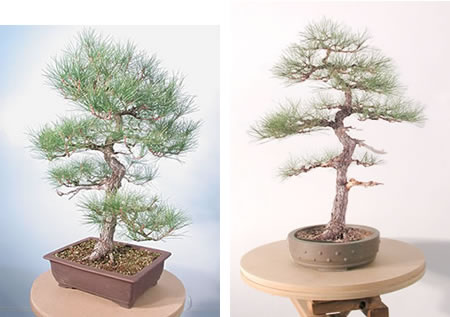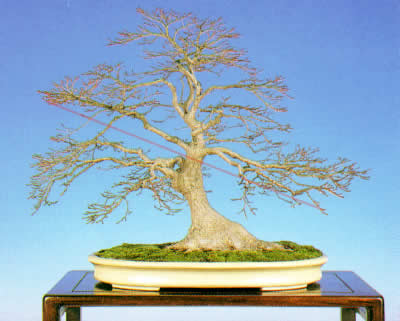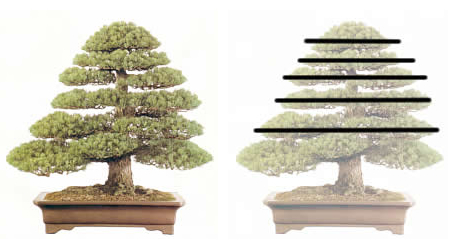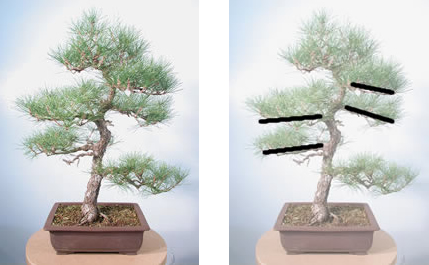4.
Toward More Artistic Design
Nature’s Irrelevancies
Blasphemy, you say? Actually, bonsai art gets more of its design license from artistic concerns than from natural ones. This is an important premise that you’ll need to cozy up to in order to produce more meaningful bonsai art. Don’t forget: artists don’t chronicle; they interpret and describe.
Compile any list of bonsai flaws and then walk out your door into your neighborhood or to a park or a forest and you will quickly be able to find every one of these bonsai no-no’s on the trees you see. However, it is important to understand that the existence of these growth forms on trees in nature is largely irrelevant to your endeavor of bonsai design. What is relevant is what these growth forms on a bonsai communicate or fail to communicate to the viewer of a bonsai, and how they contribute to and detract from design objectives.
The fact is, these growth forms that are considered to be bonsai flaws are flaws not because nature or the rules say so, but because they don’t generally contribute to effective, concise design and communication. They generally run counter to your aims in artistic communication. Further, they are not part of what we generally recognize as beautiful on a very basic level.
Caveat: This is a general guideline and is not meant to say that imperfect elements found on trees in nature should always be eliminated from your bonsai. But, it is generally true. There are ways to use nature’s imperfections artistically. These seeming violations of basic convention are not easily explained by basic convention, but they do make reference to basic convention by way of what they accomplish. Understanding what is communicated by a particular imperfection can easily make its use a successful one. Success demands understanding.
Non-Natural Elements of Bonsai Artistry
You may find it odd that when working to portray the image of a great tree it is usually advisable to avoid some common tree structures found in nature. Again, the reasons are artistic in nature (if you’ll pardon the pun).
Simplify Your Life
One of the basics of artistry is simplification. Simplification is employed for a couple of reasons having to do with human perception. That, and the fact that in art we suggest and interpret; we don’t chronicle.
Firstly, trees are physically complex organisms. Since with bonsai we are working with very small-scale structures, we just have to simplify when rendering the basic structures. This is because we don’t have the same amount of real estate to work with. Scaling down necessitates simplification.
Another reason for simplification has to do with the idea that you can’t account for everything that viewers will see in your work. A wonderful example of this ideal comes from something that motion picture director, Steven Spielberg once said in an interview. He noted, and I’m paraphrasing, that many elements of a film are left unrefined or somewhat undefined “…because the audience brings, collectively, far more imagination than we can specifically account for,” or some such sentiment.
For our purposes, what he says suggests that if we try and account for every little natural detail in our bonsai work, we effectively eliminate content/meaning more than we include it. We simplify to allow for suggestion on our part and imagination on the part of the viewer.
A tangled web
One of the more important applications of bonsai refinement and artistic simplification is to that of branch and shoot arrangement. The branches of large trees growing in nature are usually quite chaotic in composition. They grow every which way (and violate all manner of bonsai composition guidelines), but the overall effect is often quite smooth and appealing. Try this with bonsai and you get anything but an appealing image.
When arranging the secondary and tertiary shoots on bonsai branches, you have to create some semblance of order. Reasons for this, again, include the artistic principle of simplification. Another reason is that you need to use these shoots to help bring consistency to your design. These branches and shoots need to help to communicate the message/image that you are aiming for and a tangled mass of chaotic shoots usually communicates little more than neglect.
Furthermore, there is the annoying issue of scale. On a large tree in nature, the leaves or needles are very, very small in relation to the branches and trunk. Not so with bonsai. This is why we generally work to form bonsai branches and leaves into foliar pads. This affectation of order helps to take emphasis away from the fact that the leaves or needles are so out of scale with the entire composition. This form provides more emphasis on the outline of the foliar structure rather than on its individual pieces, as in the photos below:

As simple as 1,2,3
Another artistic tool that is important to bonsai is the concept of basic branch order. Misunderstanding of this concept, or perhaps the reason for it, has led to the bonsai cliché of a “1-2-3 tree.” This “1-2-3” concept is concerned with the ideal of right-back-left or right-left-back branch order for bonsai.
This basic bonsai branch composition owes allegiance to the artistic ideas of flow and rhythm (eye-flow). This 1-2-3 branch order is the bonsai mechanism for inducing a specific flow that carries the viewer’s eye into and around the composition. Now, the branch order need not necessarily be left-back-right, but there does need to be a logical flow to the branch order, else the viewer’s eye will avoid certain areas or will stop with no logical place to resume. Quite simply, poor branch order causes disinterest.
Bar-branches (2 branches emerging at the same level on opposite sides of the trunk), for instance, cause the viewer’s eye to stop and provide no clear indication for how to continue. Obviously, the viewer does continue, but there is an uncomfortable interruption in what should be a natural path into and around the bonsai composition. A tree with a bar-branch structure almost appears to be two trees; one below the bar branches and one above them. This creates a quite literal interruption of design integrity (two parts instead of one whole).
The usually horizontal line formed by bar-branches that bisects the trunk mirrors the soil line. It suggests a horizon or landscape level that is always out of place in a tree. Branches are your mechanism for inducing flow and rhythm. Bar-branches form a line reference for a “full stop.”
There are horticultural and other aesthetic reasons for avoiding bar-branch structures, too. Left for a long time, bar-branches will cause an ugly swelling on the trunk. This swelling may not appear for a few years, but it will happen eventually. There is no reason to let that happen and ruin an otherwise nice bonsai.
.jpg)

As the artist, it is your responsibility to invite the viewer into the composition and lead them through it, to some degree. This is true of all art. This must be done by the way the bonsai structure is composed. If you fail to address this important element of artistic composition, your work will lack interest and have diminished appeal to most viewers.


Conclusion
As with many of the basic artistic conventions, there are also ways to use a violation of these principles toward an artistic end. First, however, learn how to successfully adhere to these principles before you concern yourself with violating them. The “rule” is not what is important. What is important is what necessary aesthetic issue the “rule” addresses. As an artist, you may find creative ways of addressing the issue — but, of course, not until you understand the issue.
The elements of composition covered in the above section are found to one degree or another in the basic, commonly cited design guidelines for bonsai common to most bonsai books. Delve deeply into these conventions and work to understand what they each seek to accomplish from a design and horticultural standpoint. As an artist, you may then be able to find alternate ways of addressing the results these conventions facilitate. This is artistry.
Next, we examine some ways of directly connecting with your audience and leading them to the good stuff and away from the badness in your designs.